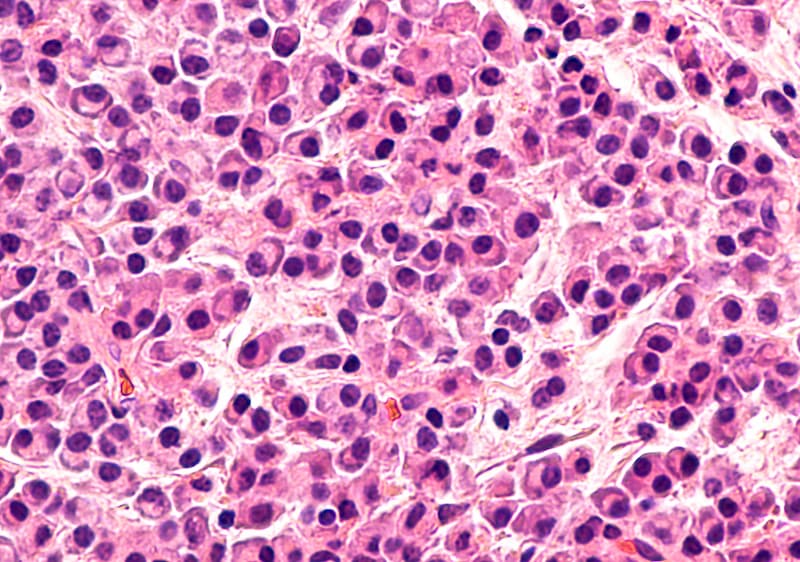Talquetamab Combo Yields Enduring Responses in R/R Multiple Myeloma
Combining talquetamab with teclistamab elicits responses even among those with extramedullary disease in the RedirecTT-1 trial.
Combining talquetamab with teclistamab elicits responses even among those with extramedullary disease in the RedirecTT-1 trial.

Administering talquetamab-tgvs (Talvey) in combination with teclistamab-cqyv (Tecvayli) produced a high rate of durable responses among patients with triple-class exposed relapsed/refractory multiple myeloma, according to data from the phase 1b RedirecTT-1 study (NCT04586426) presented at the 21st Annual International Myeloma Society Meeting and Exposition.1
At the recommended phase 2 regimen (RP2R) of talquetamab at 0.8 mg/kg plus teclistamab at 3 mg/kg every other week, data showed an overall response rate (ORR) of 79.5% among 44 evaluable patients. Study treatment yielded a complete response (CR) or better rate of 52.3%, with responses ongoing in 85.9% of patients at 18 months. Additionally, the 18-month progression-free survival (PFS) rate was 69.8% after a median follow-up of 18.2 months.
In a subgroup of 18 patients with extramedullary disease (EMD), talquetamab/teclistamab at the RP2R produced an ORR of 61.1% and a CR or better rate of 33.3%. At 18 months, 81.8% of responders in this subgroup had ongoing responses. After a median follow-up of 13.6 months in the EMD subgroup, the PFS rate was 52.9% at 18 months.
Combining talquetamab with teclistamab in the RedirecTT-1 trial produced a safety profile that was comparable with prior reports of each agent when administered as monotherapy. The rate of grade 3/4 infections was slightly higher with the combination therapy compared with prior monotherapy reports, although these toxicities plateaued from 6 months. Non-hematologic adverse effects (AEs) were typically low-grade and consisted of taste (50%), non-rash skin (56.8%), and nail toxicities (47.7%). No patients discontinued study therapy due to cytopenias.
“As multiple myeloma progresses, it becomes more difficult to treat, especially in patients with extramedullary disease, which spreads beyond the bone marrow and typically becomes resistant to standard therapies,” lead study author Yael Cohen, MD, head of Myeloma Unit, Hematology Institute, Tel Aviv Sourasky Medical Center, Israel, said in a press release on these findings.1 “These results reflect promising efficacy and a manageable safety profile for this combination of 2 first-in-class, innovative bispecific therapies and provide a potentially promising off-the-shelf option for patients with advanced multiple myeloma.”
Investigators of the ongoing dose-escalation phase 1b trial are assessing talquetamab in combination with teclistamab for 208 patients with relapsed/refractory multiple myeloma. In part 1, patients were assigned to receive talquetamab/teclistamab with or without daratumumab (Darzalex) as part of 28-day cycles following step-up dosing. In parts 2 and 3, patients will receive the RP2R of talquetamab at 0.8 mg/kg plus teclistamab at 3 mg/kg every other week.
The trial’s primary end points include the incidence and severity of dose-limiting toxicities in part 1, incidence and severity of AEs in part 2, and ORR in part 3.2 Secondary end points across all parts include the CR or better rate, stringent CR rate, DOR, time to response, PFS, and overall survival.
Patients 18 years and older with documented multiple myeloma per International Myeloma Working Group criteria and relapsed/refractory disease following prior receipt of a proteasome inhibitor, immunomodulatory drug, and anti-CD38 monoclonal antibody are eligible for enrollment on the trial. Additional requirements for study entry include having an ECOG performance status of 0 or 1 in parts 1 and 2 and a performance status of 0 to 2 in part 3.
Those who have received targeted therapy, epigenetic therapy, or treatment with an investigational agent within 3 weeks of entry are ineligible for enrollment on the trial. Patients are also unable to enroll if they have allogeneic stem cell transplant within 6 months of entry or central nervous system involvement or clinical signs of meningeal involvement.
References
- Novel combination of TALVEY® (talquetamab-tgvs) and TECVAYLI® (teclistamab-cqyv) suggests high response rates and durable responses in triple-class refractory patients with relapsed or refractory multiple myeloma, including those with extramedullary disease. News release. Johnson & Johnson. September 27, 2024. Accessed September 27, 2024. https://tinyurl.com/2ypyh3n5
- A study of the combination of talquetamab and teclistamab in participants with relapsed or refractory multiple myeloma (RedirecTT-1). ClinicalTrials.gov. Updated September 19, 2024. Accessed September 27, 2024. https://tinyurl.com/2m4zkdue